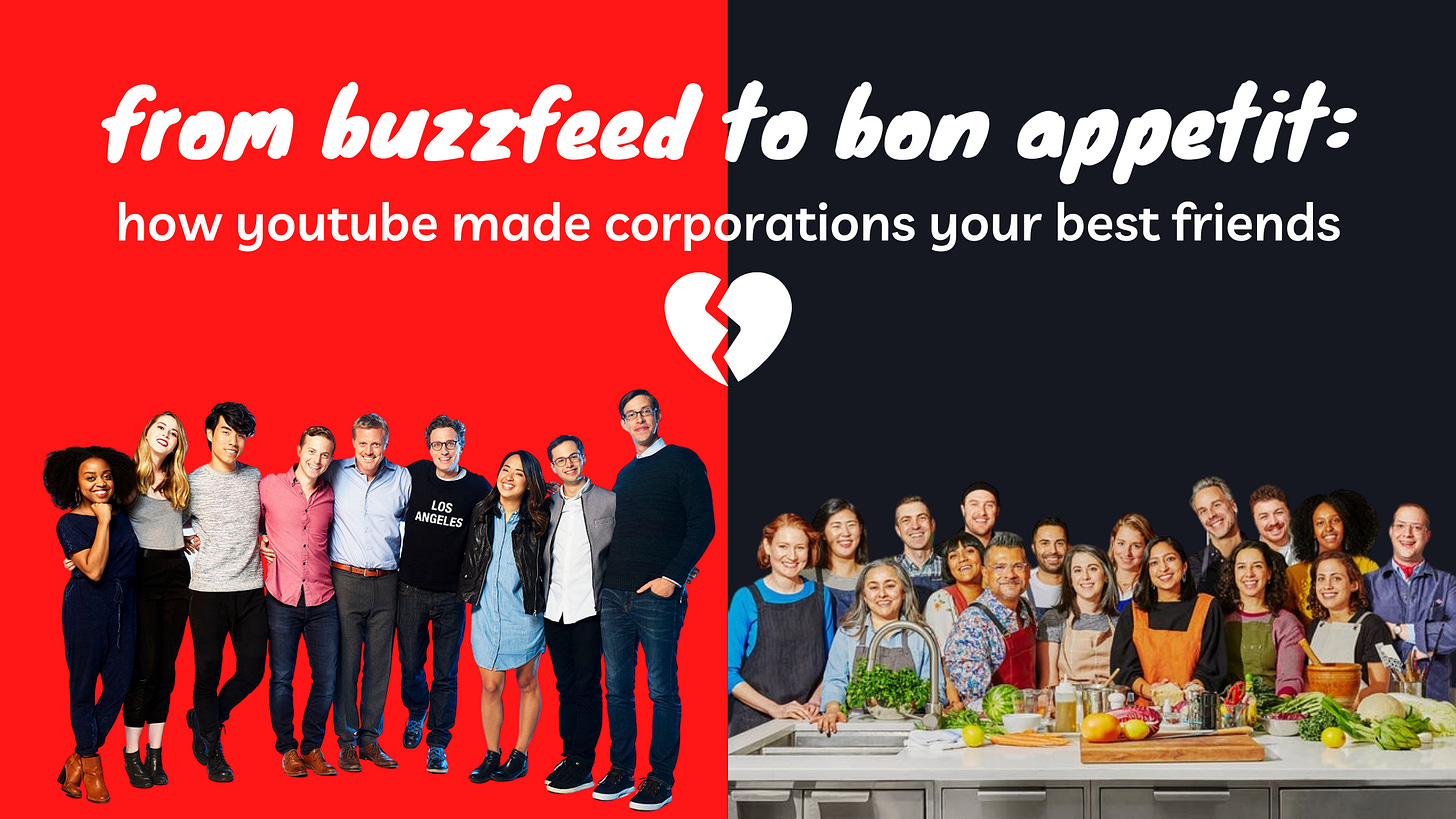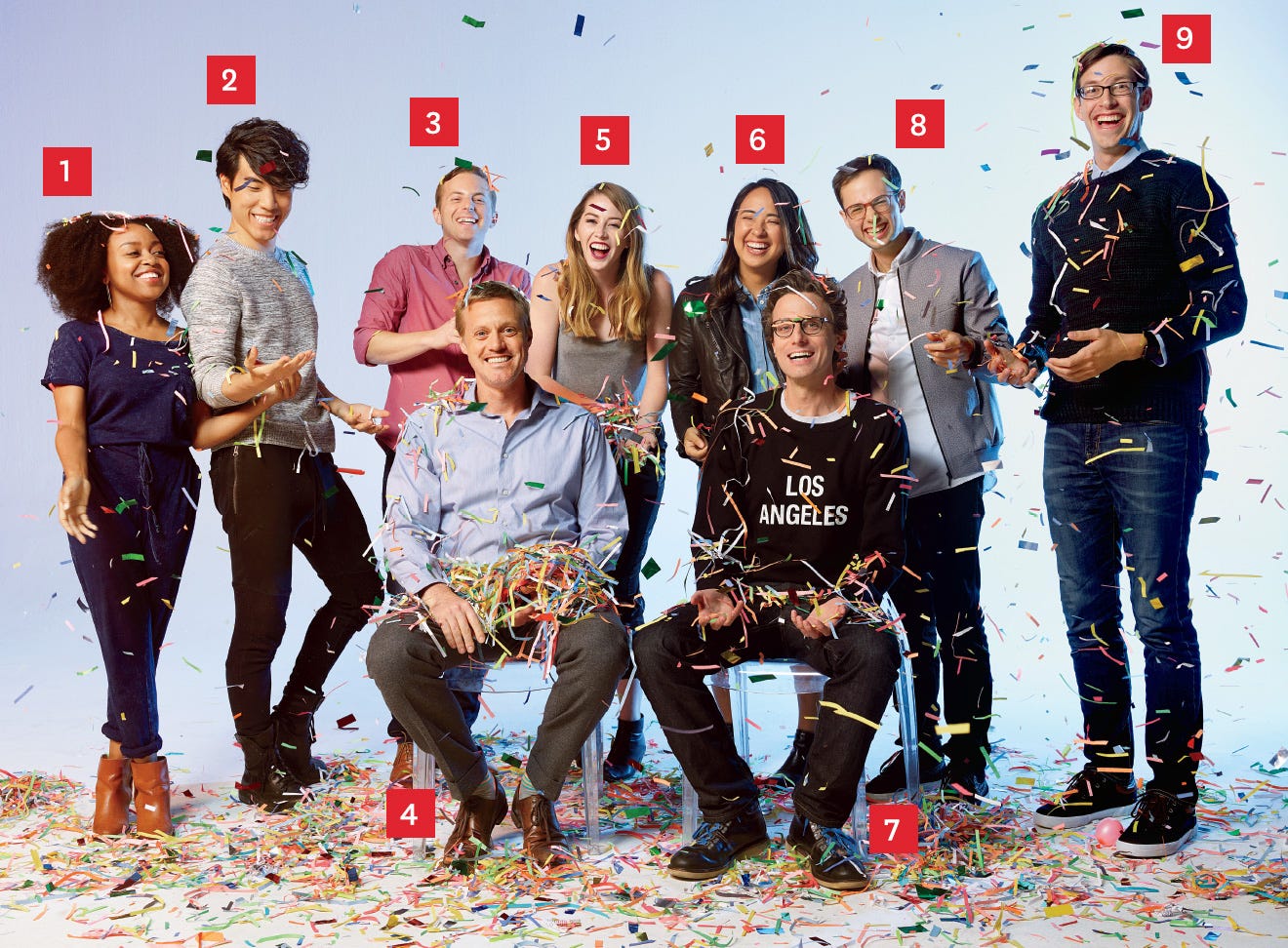From Buzzfeed to Bon Appétit: How Youtube Made Corporations Your Best Friends
An overview into the rise and fall of parasocial relationships with corporations in the digital age

Heywhat’supyouguysbeforeIstartthenewsletterdon’tforgettoSMASHthatlikebutton!
Did you have an aneurysm? So did I!
Confession time: I used to be a big Buzzfeed fan. I’m not talking about the website and their ham-fisted quizzes or clickbait headline. I’m talking about Buzzfeed Video. Back in the first days of Buzzfeed, before it became weird (as in, “Dude Who’s Never Eaten a Fruit Eats a Fruit” weird), it was full of filmed sketches marketed as relatable content. Buzzfeed Video’s various channels in the early 2010s were dominated with Youtube videos like “Weird Ways You Hide Your Crush” or “When You’re Forced to Hang Out with a Kid”.
An interesting thing started happening though. The cast (who also doubled as Buzzfeed producers, editors, writers and more) recurred in every video in loose storylines. People started learning their names. Buzzfeed Video had its own parallel world, a canon with a circle of characters they shipped together and rooted for. With their on-screen characters using their real names and personas, there was rarely a separation from cast to character.

Hollywood Reporter
Buzzfeed Video had a fandom. Its success brought a rebrand towards Buzzfeed Motion Pictures and exclusive deals and contracts with their stars. Even with its grandiose new business format, it started seeping into a very familiar territory. It felt like your favourite Youtuber, but it was a whole company instead.
There’s a term called parasocial relationships, which sounds like a term to describe a parasitic relationship and well, it kinda is. It’s the symbolic, one-sided relationship people form with celebrities and media figures. It’s the idea that the people you’re seeing on your screen aren’t just entertainers (spoiler alert: they are), but they’re your friends. Maybe even your best friends? They greet you with “hey guys!”, lament to you about their day and call you family, as if you’re someone at Sunday brunch and not a consumer of their material. For corporations like Buzzfeed, this was intentional. In an article from The Verge aptly called “Youtubers Are Not Your Friends”, Leslie Rasmussen of Xavier University notes that “some Youtubers may not even be aware they’re cultivating parasocial relationships [but] the steps they take to grow their audiences are exactly that.”.
While the talent of Buzzfeed became minor celebrities, the real star of the parasocial relationship was the company itself. Through their fun, innocuous sketches of the Buzzfeed Video employees goofing off, it was easy to believe the company was a blast to not only watch, but to work at. It seemed like every day at Buzzfeed was one where people woke up and sat in their sun-drenched minimalist office to interact with celebrities and hang with their work-turned-family friends. With Buzzfeed using a place like Youtube, accessible to essentially anyone with a Wi-Fi and a working smartphone, it was easy for the company to coax everyone into a false sense of security. They were a fun company. We’re not like other corporations, we’re a cool corporation! Don’t you wanna work here?
Eventually, Buzzfeed Video’s golden era came to an end. “Why I Left Buzzfeed” became as much a genre as apology videos from racist beauty Youtubers. People cited a lack of creative control, unfair contracts and a need to pursue greater projects as a reason for their departure. Just as their content was viral, their exodus was too. Buzzfeed was no longer the prime media company people wanted to work with. So when fan favourites left, the audience followed.
While Buzzfeed Video may have started the trend of corporations masking as friendly faces on Youtube, Bon Appétit’s Test Kitchen exacerbated it to the next level. Bon Appetit’s Youtube channel came into my radar well into my first year post undergraduate. I was fully aware of how no matter what, large companies weren’t safe spaces for marginalized communities. Especially a company as big as Conde Nast, the owner of Bon Appétit. It felt all too familiar to what I saw a few years prior to Buzzfeed. But I fell into it anyway. There’s a calming sensation around watching people cook. There is nothing purer.
With the arrival of Bon Appétit’s Test Kitchen, we got something like ‘The Office’ and ‘Parks and Rec’, even down to the handheld cinematography. Comments talked about how fun and wholesome the environment looked while every Test Kitchen employee was ineffably charming to watch. The cycling cast of BA Test Kitchen stars appeared in each other’s respective shows too, like a cross-over episode. It was like watching a cinematic universe. The Bon Appétit Cinematic Universe, if you will. Plus, BA Test Kitchen had people of colour! More than one! So they’re good guys...right?



Comments from various BA Test Kitchen videos on Youtube
I was wrong of course. At the height of the Black Lives Matter movement in June of this year, the mirage of the happy stainless steel kitchen of Bon Appétit faded when fan favourite Sohla El-Waylly posted on Instagram that she wasn’t paid for video appearances. Several other employees of colour, past and present shared their experiences of racism and unfair wages. After weeks of negotiations, some of their biggest stars of the video team, including Sohla, left. Turns out a company would rather keep their racist practices than keep their biggest moneymakers. People unsubscribed in droves. Another one bites the digital dust.
I’m not saying these companies started video segments as propaganda for their work and as a greater whole, capitalism itself, but the product and the unwavering affection it procured from people definitely worked in favour for the corporations. Both Buzzfeed and Bon Appétit’s videos served as pretty postcards for the companies. With Buzzfeed’s Los Angeles office, everything seemed peachy keen. There were bright coworking spaces and hot people and cereal bars. At Bon Appétit, New York was the culinary playground for the cast of BA Test Kitchen to have fun romps and eat everything off the menu of a Manhattan restaurant, on their company’s credit card. In addition, both companies had their talent interact with fans on other social media platforms. Wildly popular segments like Buzzfeed Unsolved hosted fanart showcases and appeared at conventions. Bon Appétit had parties fans could attend. It was easy to believe there was no divide between entertainer and fan, corporation and consumer, because of the sheer amount of digital intimacy they gave. It made people forget that corporations could take away your healthcare, make you suffer under racist superiors and suspend you for tweeting the truth. It was a smokescreen.
You know, I don’t fault people for liking these videos. I can’t be the pot calling the kettle black because I am (was) one of those people. We’re fed into the idea that these modern workplaces can be fun and fuss-free. Everywhere we look, these millennial and Gen Z corporations tell us yes, you too can work in a Dan Goor/Michael Schur co-production! The myth of an easy workplace, one that is devoid of capitalism’s pitfalls, is something we all dream of. When corporations merge with accessible media like Youtube, it’s hard to not separate the fact from the fiction. Especially when companies erase the lines with ease. We can’t fault ourselves for the need for escapism. We just want to believe we don’t have to bite the hand that feeds us.
GUILTY PLEASURE RANKING: 4 out of 5
If you had asked me about 3 months earlier, I would’ve ranked this a solid 1, at least for Bon Appétit. They were videos about cooking! How am I supposed to cancel videos about croque monsieurs? I was wrong. Very wrong. Anyway, #BackpayForSohla.

